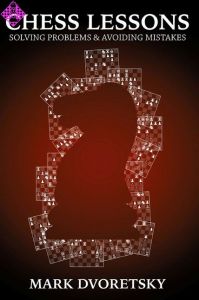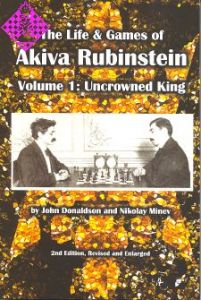Article Number
LOSOSDTSS
Author
Double Trouble Scandinavian Style
176 pages, paperback, Russell Enterprises, 1. edition 2024
The Early Equalizer
In response to 1.e4, White’s most common first move, it has long been recognized that when and if Black can play ...d5 safely, the result is approximate equality. Scandinavian devotees argue all that can happen on Move 1! But it’s hardly a ”peaceful“ equality.
But do we really need a book that is a blur of all sorts of black and white possibilities with countless tightly-nested game fragments? Hardly. Double Trouble is a straightforward volume of repertoire recommendations, easy to understand and easy to play.
The book is in three parts. Part One, besides introducing the book generally, covers the very first moves of the Scandinavian Defense and White’s early deviations. Anyone who plays the Scandinavian will find this section quite helpful. Then Part Two covers Qd6 + g6 systems, while Part Three covers the very different Nf6 system.
"In this book, popular author and Correspondence Master Marek Soszynski gives you a defense to 1.e4 that can honestly be called ”complete.“ Your prep could not be better...This book cuts [the theory] down to size. Marek Soszynski gives you just what you need to know to show that the old ”theoretical“ equalizer, 1...d5, can indeed be played, and played with verve, on Move 1!"
- From the Foreword by Al Lawrence
Double Trouble Scandinavian Style: Equalize early and then play for a win!
About the Author
Marek Soszynski is a Correspondence Chess Master and a Master of Philosophy. He himself has authored or co-authored a growing number of chess books including How to Think in Chess, and The Polish Defense.
In response to 1.e4, White’s most common first move, it has long been recognized that when and if Black can play ...d5 safely, the result is approximate equality. Scandinavian devotees argue all that can happen on Move 1! But it’s hardly a ”peaceful“ equality.
But do we really need a book that is a blur of all sorts of black and white possibilities with countless tightly-nested game fragments? Hardly. Double Trouble is a straightforward volume of repertoire recommendations, easy to understand and easy to play.
The book is in three parts. Part One, besides introducing the book generally, covers the very first moves of the Scandinavian Defense and White’s early deviations. Anyone who plays the Scandinavian will find this section quite helpful. Then Part Two covers Qd6 + g6 systems, while Part Three covers the very different Nf6 system.
"In this book, popular author and Correspondence Master Marek Soszynski gives you a defense to 1.e4 that can honestly be called ”complete.“ Your prep could not be better...This book cuts [the theory] down to size. Marek Soszynski gives you just what you need to know to show that the old ”theoretical“ equalizer, 1...d5, can indeed be played, and played with verve, on Move 1!"
- From the Foreword by Al Lawrence
Double Trouble Scandinavian Style: Equalize early and then play for a win!
About the Author
Marek Soszynski is a Correspondence Chess Master and a Master of Philosophy. He himself has authored or co-authored a growing number of chess books including How to Think in Chess, and The Polish Defense.
| EAN | 9781949859812 |
|---|---|
| Weight | 250 g |
| Manufacturer | Russell Enterprises |
| Medium | Book |
| Year of Publication | 2024 |
| Author | Marek Syszynski |
| Language | English |
| Edition | 1 |
| ISBN-13 | 978-1-949859-81-2 |
| Pages | 176 |
| Binding | paperback |
005 Preface
006 Foreword by Al Lawrence
Part One
009 1) Introduction to Double trouble
012 2) Introduction to 1.e4 d5
014 3) White Avoids 2.exd5
021 4) Illustrative Games
Part Two
028 5) Introduction to 2...Qxd5
031 6) 3.Nc3 Qd6 4.d4 and others
034 7) Kurajica Variation 4...g6
038 8) Czebe Variation 4...Nf6 5.Nf3 g6
047 9) Illustrative Games
Part Three
082 10) Introduction to 2...Nf6
084 11) 3.d4 Nxd5
093 12) 3.Bb5+ Nbd7
097 13) 3.c4 c6
105 14) 3.Nf3 and others
107 15) Illustrative Games
147 16) More Games (Parts Two & Three)
171 Addendum: Englund Gambit Reversed
173 Select Bibliography
174 Abbreviations
174 Signs & Symbols
175 Index of Players
006 Foreword by Al Lawrence
Part One
009 1) Introduction to Double trouble
012 2) Introduction to 1.e4 d5
014 3) White Avoids 2.exd5
021 4) Illustrative Games
Part Two
028 5) Introduction to 2...Qxd5
031 6) 3.Nc3 Qd6 4.d4 and others
034 7) Kurajica Variation 4...g6
038 8) Czebe Variation 4...Nf6 5.Nf3 g6
047 9) Illustrative Games
Part Three
082 10) Introduction to 2...Nf6
084 11) 3.d4 Nxd5
093 12) 3.Bb5+ Nbd7
097 13) 3.c4 c6
105 14) 3.Nf3 and others
107 15) Illustrative Games
147 16) More Games (Parts Two & Three)
171 Addendum: Englund Gambit Reversed
173 Select Bibliography
174 Abbreviations
174 Signs & Symbols
175 Index of Players
A plain and principled foundation.
In this book Marek Soszynski provides black with two defences against 1.e4, each being a line of the Scandinavian Defence. The first line is 1.e4 d5 2.exd5 Qxd5 3.Nc3 Qd6 4.d4 Nf6 (4…g6 at once, a move attributed to GM Bojan Kurajica, is considered briefly, but there does not appear to be any particular advantage to playing in this way) 5.Nf3 g6, which Soszynski calls the Czebe Variation, after GM Attila Czebe. While the second line is the no-nonsense 2…Nf6, aiming to recapture the pawn with the knight. In addition, any and all attempts by white to avoid these lines are thoroughly covered, whether that be on the second move by 2.Nc3 or 2.d4, or on the third move (following 2…Qxd5) by 3.Nf3 or 3.d4, or indeed other moves. All that you might need to meet 1.e4 with 1…d5 can be found within the book’s covers.
What I’d say about Soszynski’s lines and his distinctive way of treating them (for example: retreating the knight from …d5 to …f6 instead of …b6 in response to c4 in the second line) is that while his approach is surprising, innovative and requires little preparation (compared to the Sicilian, say), the two lines differ rather in character. There is a solidity to the Czebe Variation (though it is slightly provocative) and it can withstand the impetuous 6.Nb5, the quiet 6.Be2, the prophylactic 6.h3 and other white attempts at advantage besides. (Also, interestingly, black will sometimes later go …a6, …b5 and then …c5, leading to a sort of delayed Sicilian; something that can happen in the Caro-Kann too.) Whereas, by contast, 2…Nf6 aims for active play right from the off, even at the cost of a pawn: 3.c4 c6 and 3.Bb5+Nbd7 4.c4 a6 5.Ba4 b5 are two of Soszynski’s recommendations; and both gambits seem sound.
As for the format of the book, there is a bare bones, albeit sometimes intricately skeletal, theory section that is fleshed out later, where need be, by several illustrative games, of which there are 64 altogether. Unusually, the diagrams show you the position from black’s point of view throughout. I can recall one book where this was sometimes done, which was in W. H. Cozens’s excellent The King Hunt. He had diagrams that showed you the position from the point of view of the hunter, that is the victor, who may have been playing white or black. But I am struggling to come up with another example.
Anyway, it is clear that the two vital lines of defence advocated by Marek Soszynski are fully viable for black. If you are looking for a straightforward defence to 1.e4, based on a plain and principled foundation, this book provides one solution.
Paul Kane
https://thecaissakid.wordpress.com/2024/06/21/double-trouble-scandinavian-style/
In this book Marek Soszynski provides black with two defences against 1.e4, each being a line of the Scandinavian Defence. The first line is 1.e4 d5 2.exd5 Qxd5 3.Nc3 Qd6 4.d4 Nf6 (4…g6 at once, a move attributed to GM Bojan Kurajica, is considered briefly, but there does not appear to be any particular advantage to playing in this way) 5.Nf3 g6, which Soszynski calls the Czebe Variation, after GM Attila Czebe. While the second line is the no-nonsense 2…Nf6, aiming to recapture the pawn with the knight. In addition, any and all attempts by white to avoid these lines are thoroughly covered, whether that be on the second move by 2.Nc3 or 2.d4, or on the third move (following 2…Qxd5) by 3.Nf3 or 3.d4, or indeed other moves. All that you might need to meet 1.e4 with 1…d5 can be found within the book’s covers.
What I’d say about Soszynski’s lines and his distinctive way of treating them (for example: retreating the knight from …d5 to …f6 instead of …b6 in response to c4 in the second line) is that while his approach is surprising, innovative and requires little preparation (compared to the Sicilian, say), the two lines differ rather in character. There is a solidity to the Czebe Variation (though it is slightly provocative) and it can withstand the impetuous 6.Nb5, the quiet 6.Be2, the prophylactic 6.h3 and other white attempts at advantage besides. (Also, interestingly, black will sometimes later go …a6, …b5 and then …c5, leading to a sort of delayed Sicilian; something that can happen in the Caro-Kann too.) Whereas, by contast, 2…Nf6 aims for active play right from the off, even at the cost of a pawn: 3.c4 c6 and 3.Bb5+Nbd7 4.c4 a6 5.Ba4 b5 are two of Soszynski’s recommendations; and both gambits seem sound.
As for the format of the book, there is a bare bones, albeit sometimes intricately skeletal, theory section that is fleshed out later, where need be, by several illustrative games, of which there are 64 altogether. Unusually, the diagrams show you the position from black’s point of view throughout. I can recall one book where this was sometimes done, which was in W. H. Cozens’s excellent The King Hunt. He had diagrams that showed you the position from the point of view of the hunter, that is the victor, who may have been playing white or black. But I am struggling to come up with another example.
Anyway, it is clear that the two vital lines of defence advocated by Marek Soszynski are fully viable for black. If you are looking for a straightforward defence to 1.e4, based on a plain and principled foundation, this book provides one solution.
Paul Kane
https://thecaissakid.wordpress.com/2024/06/21/double-trouble-scandinavian-style/
More from Russell Enterprises
-
 Max Euwe€7.95
Max Euwe€7.95 -
 Mikhail Botvinnik€9.95
Mikhail Botvinnik€9.95 -
 Chess Lessons€14.95
Chess Lessons€14.95 -
 Understanding Queen Endgames€16.95
Understanding Queen Endgames€16.95 -
 The Chameleon Variation€5.95
The Chameleon Variation€5.95 - More from Russell Enterprises



